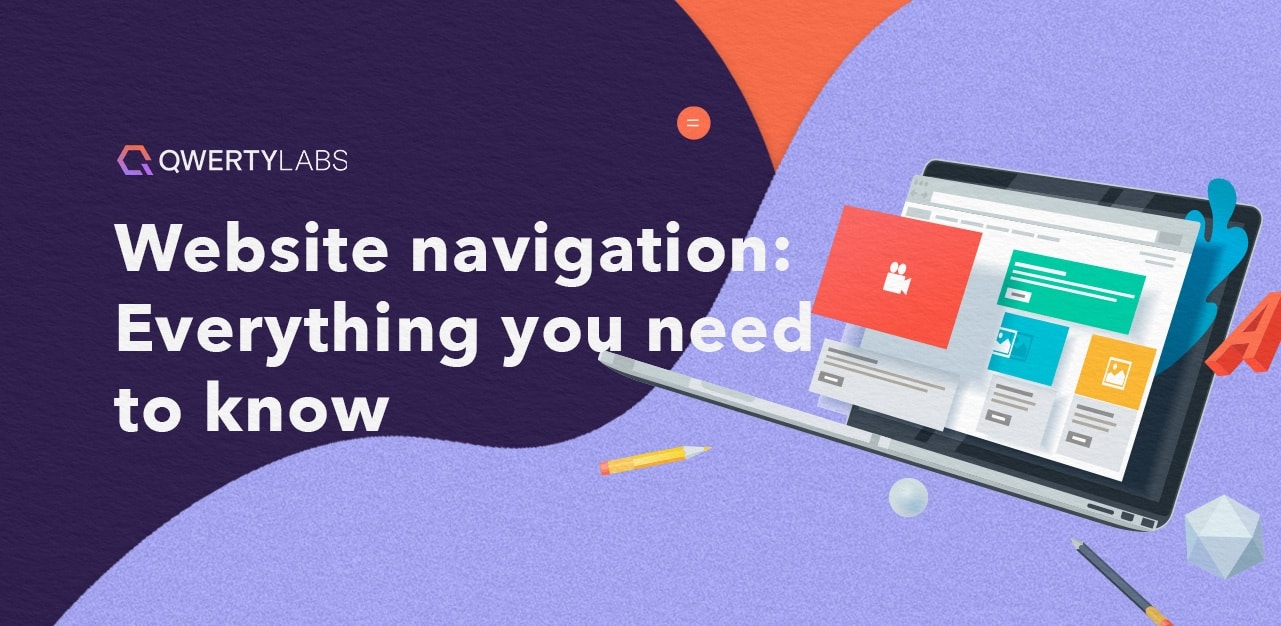Engage your audience with the right brand event marketing strategy. Discover tips and tricks to create impactful events with QWERTYLABS.

Building an online presence is crucial to stand out in a highly competitive market. Website creation is one of the most effective ways to do so. Besides putting your brand out there, you are also building recognition and a reputation in your niche.
Of course, as a website owner, it is crucial to work on the site’s user experience by focusing on different aspects. One important factor to work on is website navigation. This is the process of navigating through a site’s pages, content, and information architecture. To help you further understand, here is a website navigation guide from QWERTYLABS that will help you learn the description and everything you need to know about it:
Website navigation meaning is finding your way through and around a website through its user interface. Visitors can do this by interacting with the different features and elements placed by the web page owner across their site. One of the common elements you will encounter is a link. Other features include buttons, menus, tabs, and many more.
When accessing a site, there are different entry points a visitor can go through. Users often access a website by typing its address on a search engine or through other means such as links. Creating a site that is easily navigated from one page to another is important.
The importance of navigation is often underestimated by many site owners. Although building the most optimal user experience is a lengthy and difficult process, it is always a worthy one to go through. This is because it is a win-win situation for both you and your visitors.
Tons of benefits come from a great website navigation structure. An organised one leads to a good overall result. Here are some of them:

A website navigation menu is a front-end graphical user interface (GUI) element where users can access different internal site pages found on a site. Typically found on the header of the homepage, this is the most optimal way to help users navigate your site with ease.
To improve the site’s overall functionality in terms of its website navigation menu and web content management, the front-end and the back-end of the site needs to work hand-in-hand by communicating. The front end of the site is what users see, while the back end is where everything in the background happens such as storing and organising data.
There are different types of website navigation bar menus you can opt for. Each serves its purpose and follows a pattern that differentiates it from the others. Depending on the site you are set on creating, here are the types to choose from:
Mega menu gives users a comprehensive overview of a website’s offerings. These are often used with sites that have a large amount of content and categories that could be too complex to navigate. This allows users to quickly view and see what the site has to offer.
A tabbed menu allows users to switch between different sections or categories of content. This is done by clicking on tabs that can be laid out horizontally or vertically. Each tab represents a different section of content, and when the user clicks on a tab, the corresponding section of content is displayed while the others remain hidden.
Another type of website navigation is an accordion menu. This is used for presenting site architectures with complex information in an organised manner. This type uses pagination which allows users to expand and collapse sections of a menu to reveal subcategories related to what they clicked on. It usually appears as a vertical list of items or sections.
Faceted menus or faceted search or filtering, is another type of website navigation. This type typically appears on search or product listing pages and allows users to narrow down their search results based on attributes. Users can refine their search results by selecting one or more filters or categories.
Anchor link navigation refers to the practice of using hyperlinks to allow users to quickly jump to specific sections or elements within a web page, without having to manually scroll through the entire page.
This type of navigation assists site visitors to move sideways across the structure and hierarchy to pages associated with the niche. This was designed to provide users with a clear and easy-to-use pathway to other relevant content on the site, based on their current context or interests.
It is crucial to pick the right way to structure your site database navigation and content management system. During the planning phase, you have to consider hyperlink placement, site design, what image and button assets to use, and the content found in the page footer.
With this, there are different types of navigation to consider for your site that will help you plan these out. Choosing the right type can impact whether your visitors will stay or immediately leave. Here are the types:
As the name states, you will find the menu items horizontally typically on the top of your screen. This type allows users to view the options with ease and scan through to the content they want to visit.
This type of menu, on the other hand, is oriented vertically as the name suggests. Here, you will find a list of links or menu items from either the left or right side of your screen. It is often used by sites that have lots of content to be consumed.
A drop-down menu is often used by online shops which allows customers to browse their wares with ease. Users can hover over or click on a main menu item, revealing a list of sub-menu items. You will typically find this on the homepage of the website for easy user access.
Typically used for mobile-friendly websites, this type appears as three horizontal lines stacked on each other which resembles a hamburger. When clicked or tapped, the hamburger menu expands to reveal a dropdown menu of navigation options.
A footer menu, unlike the others, is found at the bottom of the site. Although they are not the primary type found on a site, they are still able to provide users with additional navigation options, such as links to important pages or sections of the site, contact information, or social media links.

There are different factors that entail an effective web design for navigation that improves the user experience of visitors. These are:
CSS is typically used in conjunction with HTML and JavaScript to create interactive and visually appealing HTTPS website navigation menus that are easy to use and navigate.
Websites should have structure and hierarchy to ensure that information is organised and presented properly on each page of a site. This creates an information architecture that can significantly impact consumer behaviour and how users interact with the site and find the information they need.
To create an efficient navigation system, try to take note of the following factors in your web design:
Great website navigation is intuitive and user-friendly which makes it easy for users to find what they're looking for. Here are some examples of easy-to-navigate websites to give you diagram docs idea plans for your site:
These websites demonstrate effective navigation design by prioritising the most important pages, using clear and intuitive navigation components, having their information easily available, and providing a seamless user experience across different devices.

Aside from desktop, mobile device compatibility should also be considered since the majority of traffic comes from smartphone users. A responsive design that corresponds to its screen size will allow visitors to have easy navigation while using their devices. There should be no input lag which is one of the main priorities that should be given attention in website creation.
Website navigation and Search Engine Optimization (SEO) tie together as they play a crucial role in organic traffic generation. By following proper navigation guidelines, you are enhancing the web visibility and PageRank of your site. This also allows your site to be easily accessible to both users and search engine crawlers.
You can further improve your website’s relevance in search queries by structuring your menus to categorise and prioritise pages based on their importance and relevance to the site's overall theme. Quality Raters use guidelines to evaluate a website's navigation and its impact on the user experience. A clear and user-friendly interface can lead to better engagement and higher page views.
Website navigation plays an important role in ensuring search engines can do crawling and indexing as these are critical aspects of SEO. In connection, an efficient navigation system can help distribute link juice throughout the site, which can positively impact the position on the Search Engine Ranking Page (SERP)
A sitemap can help web crawlers better understand the site's structure and locate all pages. Additionally, it aids in determining the value and relevance of each particular page for indexing.
To further improve your website navigation, you can use various web resource analytics and tracking tools available. This will show you metrics that will help you further understand user behaviour to help you optimise the site’s navigation system for the better.
One of the most popular web tracking tools available is Google Analytics. It gives businesses insights into the site’s exit rate, session duration, page views, and click-through rates. These statistics can help webmasters in understanding user navigation and pinpoint areas for development.
For instance, a high bounce rate or short session length can be a sign that consumers are having trouble locating what they are searching for and may benefit from better navigation alternatives.
Besides this, you can also conduct surveys and feedbacks. This will provide you with more valuable insights into user behaviour and navigation preferences. User feedback can also be used to set Key Performance Indicators (KPIs) and goals for navigation optimization.

There are tons of concepts that can be considered best practice when it comes to website navigation. You can further go through the process of learning and improvement by getting a better understanding through a tutorial or other specific guides.
To help you develop a sense of preference, here are helpful methods and strategies that you can implement for website navigation creation:
Optimising website navigation for every screen size is essential for providing users with a seamless browsing experience. This involves conducting research to determine how users interact with the website on different devices and developing a responsive web design that adapts to various screen sizes.
To ensure the navigation is user-friendly, it's important to prioritise the most important pages and present them clearly in the navigation hierarchy. Navigation components, such as menus and buttons, should be designed with mobile users in mind and placed in an order based on their importance. There should be a balance of user needs and technical considerations in web development.
One of the most popular and important website navigation best practices is adding breadcrumbs. What does this mean? This is a type of navigation that provides users with a trail of links. With this, users can recount their steps by checking out the path they have taken to arrive at the page they are currently on.
With the use of data analytics and tracking, you can try testing and optimising your site further to maximise the website’s usability. If your site is not performing as well as you expected, this is your call to action to improve the navigation capabilities of the pages by applying other strategies such as anchor text use.
To help web developers create the ideal website navigation, there are several tips to remember and keep in mind. Here are some website navigation techniques that will help improve your site overall:

With this blog, we hope that we were able to brief you on the concept of effective website navigation. If you need a recommendation for developing your website’s navigation interface, QWERTYLABS is a great partner. Not only do they offer the best website development services, but you can also acquire their content marketing and search engine optimization solutions.
Keep in mind everything you’ve learned in this website navigation guide. This will lead you to a great improvement in brand recognition, website traffic and engagement. So what are you waiting for? Contact us now!
How can I improve my website navigation?
By maintaining a simple yet consistent navigation structure and taking into consideration feedback you have received, you can optimise your website which will help with traffic and user engagement.
How can I measure the effectiveness of my website navigation?
You can use tools such as Google Analytics to track your website’s performance in terms of traffic and engagement. Consider different factors such as bounce rates, session duration, and exit rates to get insight into the effectiveness of your website navigation.

 A guide to proper brand event marketing to elevate your business
A guide to proper brand event marketing to elevate your business
Engage your audience with the right brand event marketing strategy. Discover tips and tricks to create impactful events with QWERTYLABS.
 Cybersecurity trends 2024: What online casinos should know
Cybersecurity trends 2024: What online casinos should know
Stay on top of your site's cyber security by learning trends like Zero Trust Security and Supply Chain Attacks. Learn more about it at QWERTYLABS.
 The latest Google search algorithm updates for SEO success
The latest Google search algorithm updates for SEO success
In 2024, Google remains the top choice for finding answers online. That’s why it continuously refines its search policies and algorithms to improve user experience (UX) and provide more accurate search results.
8F, One Trium Tower,
Filinvest Avenue, Alabang, Muntinlupa, Metro Manila
Philippines, 1799
[email protected]
+63 (02) 8971 8926